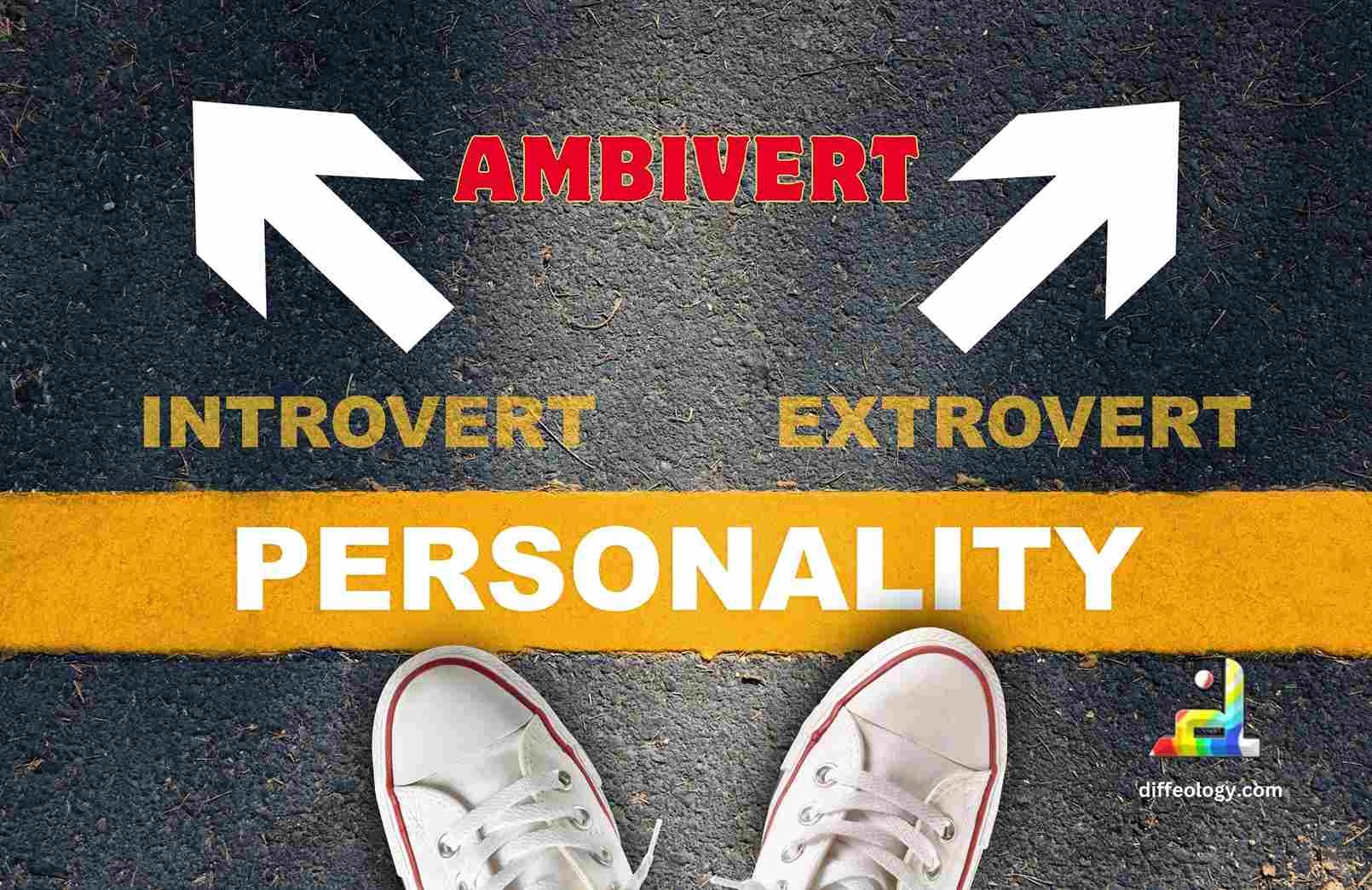Ambiverts and omniverts are terms used to describe different aspects of personality. Understanding these terms helps us grasp how people interact with others and navigate social situations. An ambivert is someone who displays a balance between extroversion and introversion, meaning they can enjoy both social gatherings and solitary activities depending on the situation. On the other hand, an omnivert can switch between being highly extroverted and very introverted, often adapting their behavior to fit the circumstances. The Difference Between Omnivert and Ambivert highlights the flexibility and complexity of human personality, showing that not everyone fits neatly into either an extroverted or introverted category.
Main Difference Between Omnivert and Ambivert
Omniverts and ambiverts both exhibit behaviors from both introversion and extroversion, but they differ in how they relate to these traits. An ambivert balances between being social and solitary, often feeling comfortable in both settings. Ambiverts tend to alternate between enjoying social interactions and needing solitude for recharge. They are adaptable to different social situations and can thrive in varied environments.
Omniverts, on the other hand, can switch between introverted and extroverted behavior more dynamically. They might be outgoing in one scenario and reserved in another, showing a wider range of social behaviors. Ambiverts typically maintain a balance between seeking social interaction and needing alone time to recharge their energy, whereas omniverts can comfortably navigate between both extremes without much adjustment.
Omnivert Vs. Ambivert
Who is an Omnivert?
An omnivert is someone who can switch between introverted and extroverted behaviors depending on the situation. Imagine you have a friend who sometimes loves being with a big group of friends, laughing and talking loudly at parties—that’s their extroverted side. But other times, they prefer to read alone in their room or play quietly with their toys—that’s their introverted side. Omniverts are like that—they can enjoy both being around people and having quiet time alone whenever they feel like it.
Read Also: Difference Between Stress and Depression
People might think of introverts as always wanting to be alone and extroverts as always wanting to be with others, but omniverts are in the middle. They can adapt and feel comfortable in different social settings. This ability to be flexible can be really helpful in making friends or doing different activities. So, if you ever meet someone who seems to be both outgoing and also likes their quiet moments, they might just be an omnivert! It’s like having the best of both worlds, being able to enjoy time with friends and time alone equally well.
Who is an Ambivert?
An ambivert is like having the best of both introverted and extroverted worlds. Imagine if you sometimes feel super happy and energized when you’re with friends, but other times, you just want to chill alone with a book or a video game. That’s what an ambivert feels like—a mix of both.
Read Also: Difference Between Elopements and Micro Weddings
Ambiverts can switch between being outgoing and quiet depending on how they feel or the situation they’re in. They’re not always super loud and social, nor are they always shy and quiet. It’s kind of cool because they can understand both introverts and extroverts really well. This flexibility helps them make friends easily and be comfortable in different places, whether it’s a big party or a quiet library. So, if you know someone who seems to enjoy both being with people and having alone time, they might just be an ambivert.
Comparison Table “Omnivert Vs. Ambivert”
| Definition | Can exhibit introverted, extroverted, or ambivert behaviors | Behavior falls between introversion and extroversion |
| Behavior Flexibility | Highly adaptable, capable of shifting behavior as needed | Adaptable comfortable in various social settings |
| Social Interaction | May appear more extroverted in certain situations | Prefers balance; neither overly extroverted or introverted |
| Energy Recharge | Can recharge energy in diverse ways depending on the context | Recharges energy through alone time or social interaction |
| Decision Making | Versatile decision-maker, adaptable to different inputs | Balanced decision-making style, considers varied perspectives |
| Communication Style | Versatile in communication, comfortable in diverse interactions | Adjusts communication to fit the social environment |
| Leadership Style | Adaptable leadership style, adjusts based on team needs | Balanced leadership approach, effective in various team dynamics |
| Comfort Zone | Moves fluidly between introverted and extroverted settings | Comfortable in both introverted and extroverted activities |
| Social Preferences | Prefers a varied social experience, ranging from quiet to lively | Enjoys a mix of socializing and solitude |
| Work Environment | Thrives in workplaces that offer diverse social interactions | Flexible in various workplace environments |
| Decision Preferences | Incorporates varied external inputs into decision-making | Considers both internal reflections and external feedback |
| Conversation Participation | Actively engages in conversations, adapting to social cues | Moderately participates in conversations based on context |
| Public Speaking | Versatile in public speaking, adjusts to audience and setting | Comfortable with moderate exposure, adapt delivery style |
| Group Settings | Can lead or follow in group settings, depending on the context | Functions well in groups with balanced participation |
| Social Comfort | Adaptable to various social settings, doesn’t favor extremes | Moderately comfortable in social environments |
| Networking | Adapts networking approach to suit different events and connections | Balances networking efforts between personal and professional |
| Personality Integration | Integrates introverted, extroverted, and ambivert characteristics | Harmonizes introverted and extroverted traits seamlessly |
Difference Between Omnivert and Ambivert in Detail
Social Preferences:
Omniverts and ambiverts differ in their social preferences. An omnivert tends to shift between being highly extroverted and highly introverted depending on the situation. They might enjoy large social gatherings one day and prefer solitude the next. In contrast, an ambivert consistently enjoys a balance between social interactions and alone time. They are comfortable in various social settings but also value moments of quiet reflection.
For example, imagine a school event where students are asked to participate in a debate. An omnivert might eagerly join in, enjoying the chance to speak in front of others, while later choosing to spend time alone reading or drawing. On the other hand, an ambivert might engage in the debate with enthusiasm but also appreciate some quiet time afterward to recharge.
Energy Levels:
Omniverts and ambiverts also differ in how social interactions affect their energy levels. Omniverts may find that socializing gives them bursts of energy but can also drain them if they don’t have enough time alone. They recharge by having alone time to process their thoughts and emotions. Ambiverts, on the other hand, tend to maintain a more stable level of energy regardless of whether they are socializing or spending time alone. They are adaptable to different situations and can enjoy both without feeling excessively drained.
Consider a class project where students need to work together in groups. An omnivert might actively participate in discussions and brainstorming sessions but then need time alone to organize their thoughts and ideas. Meanwhile, an ambivert might seamlessly switch between contributing to group discussions and enjoying quieter moments to focus on individual tasks without feeling overly tired.
Communication Styles:
Omniverts and ambiverts also have distinct communication styles. Omniverts are skilled at adapting their communication depending on whether they are in a social or solitary mood. They may be very expressive and engaging when interacting with others but more reserved when they need time alone. Ambiverts, on the other hand, tend to have a balanced communication style that is effective in both group settings and one-on-one conversations. They can listen attentively and contribute meaningfully to discussions without dominating them.
Imagine a school project presentation where students need to explain their findings to their classmates. An omnivert might take the lead in presenting key points confidently during the presentation but prefer to listen rather than actively engage in discussions during the question-and-answer session. In contrast, an ambivert might contribute to the presentation by sharing insights and also asking thoughtful questions to further understand their classmates’ viewpoints.
Decision Making:
Omniverts and ambiverts approach decision-making processes differently. Omniverts may weigh their options carefully, considering both social and personal factors that influence their choices. They may seek input from others before making a decision but also value time alone to reflect on their preferences. Ambiverts, on the other hand, tend to make decisions based on a balanced perspective that considers both their own preferences and the opinions of others. They can be decisive when needed but are also open to revising their decisions based on new information.
For instance, when planning a school trip, an omnivert might gather input from classmates about destination preferences and activities but also take time alone to finalize their decision. In contrast, an ambivert might consider various factors such as cost, distance, and group preferences before making a decision that benefits everyone involved.
Social Adaptability:
Omniverts and ambiverts show different levels of adaptability in social situations. Omniverts can adjust their behaviors and attitudes to fit various social contexts, making them versatile in different environments. They may enjoy attending parties and networking events but also appreciate quieter settings where they can recharge. Ambiverts, however, excel in maintaining a balanced approach to social interactions without feeling overwhelmed or under-stimulated. They can navigate different social situations comfortably while also valuing moments of solitude.
For example, during a school field trip, an omnivert might engage in lively conversations with classmates during bus rides and group activities but also seek out moments of quiet reflection while exploring a museum or park. Meanwhile, an ambivert might participate actively in group discussions and enjoy socializing with classmates during breaks but also take time to appreciate the surroundings independently.
Comfort Zones:
Omniverts and ambiverts have different comfort zones when it comes to social interactions. Omniverts may find themselves stepping out of their comfort zones to engage in new experiences and meet new people, balancing their need for social interaction with moments of solitude. They are willing to take risks and explore unfamiliar social settings to expand their social circles and personal growth. Ambiverts, on the other hand, tend to have a well-defined comfort zone that allows them to navigate various social situations with confidence and ease. They may enjoy socializing but also prioritize self-care and maintaining boundaries to avoid feeling overwhelmed.
For example, when participating in a school club fair, an omnivert might actively seek out opportunities to join new clubs and meet fellow students, even if it means stepping out of their usual social circle. In contrast, an ambivert might explore clubs that align with their interests and engage in meaningful conversations with club members without feeling pressured to join every club available.
Personal Growth:
Finally, omniverts and ambiverts experience personal growth in different ways based on their social preferences and behaviors. Omniverts may challenge themselves to expand their social skills and adaptability by exploring new social activities and meeting diverse groups of people. They seek opportunities to learn from both social interactions and moments of solitude to enhance their emotional intelligence and self-awareness. Ambiverts, meanwhile, prioritize balance and self-reflection in their personal growth journey. They value experiences that allow them to deepen their understanding of themselves and others while maintaining a healthy equilibrium between social engagement and introspection.
For instance, when faced with a school project that requires collaboration with classmates, an omnivert may embrace the opportunity to contribute their ideas and actively participate in group discussions, recognizing the importance of teamwork and communication skills. They may also take time alone to reflect on their contributions and identify areas for improvement. In contrast, an ambivert may approach the project with a balanced perspective, appreciating the value of collaboration while also valuing moments of solitude to process their thoughts and recharge their energy.
Key Points Describing the Difference Between Omnivert and Ambivert
- Adaptability: Ambiverts adapt their social behavior based on the situation, feeling comfortable in a variety of social contexts, whereas omniverts may switch between being highly social and preferring solitude depending on circumstances.
- Personality Traits: Ambiverts often exhibit moderate levels of traits associated with both introversion and extroversion, blending characteristics like assertiveness and sociability in different measures.
- Psychological Studies: Research suggests that ambiverts show a balanced approach to social interactions, neither consistently seeking nor avoiding them, whereas omniverts may show more variability in their social behavior over time.
- Social Comfort: Ambiverts find a comfortable middle ground between socializing and solitude, while omniverts may experience fluctuations in their comfort levels depending on the social context.
- Interaction Preferences: Ambiverts tend to enjoy socializing but also value quiet time, whereas omniverts can switch their preference based on their current mood or situation.
- Communication Styles: Ambiverts may adjust their communication style depending on who they are interacting with, while omniverts may be more consistent or variable in their approach.
- Comfort Zones: Ambiverts have a broader comfort zone that encompasses both social and solitary activities, whereas omniverts may have distinct comfort zones for each type of activity.
- Decision Making: Ambiverts may consider both internal reflections and external feedback in decision-making, while omniverts may lean more towards one or the other depending on their current social inclination.
- Social Engagement: Omniverts can switch between being highly engaged in social activities and preferring quieter environments, whereas ambiverts maintain a more balanced level of engagement across different social settings.
- Long-Term Behavior: Ambiverts demonstrate consistent behavior patterns that blend introverted and extroverted tendencies over time, while omniverts may show fluctuating patterns depending on their evolving social experiences.
FAQs: Omnivert Vs. Ambivert
Conclusion:
The Difference Between Omnivert and Ambivert is easy to understand. An ambivert is someone who shows a balanced mix of traits from both introverts (who prefer solitary activities) and extroverts (who thrive in social settings). They can enjoy socializing but also need time alone to recharge, making them adaptable to various situations depending on their mood and environment. On the other hand, an omnivert, although less commonly recognized, is described as someone who can switch between being very outgoing and social to be introspective and quiet, often in a more pronounced and varied manner compared to ambiverts. Omniverts are versatile in social situations, able to navigate different personality roles depending on the context.
References & External Links
- Ambiver or Omnivert – Which One Are You?



